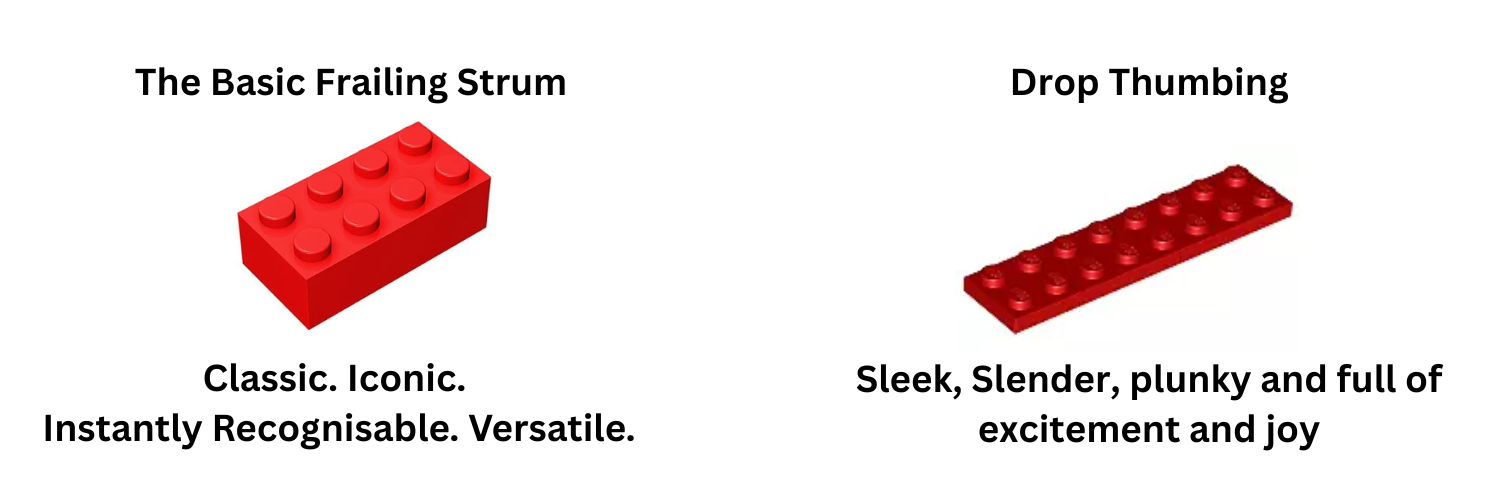Everything You Need To Know About Drop Thumbing (Clawhammer Banjo Lesson)
🎵 Drop Thumbing Demystified: A Beginner’s Guide to the Next Step After Frailing
By Ben Dorning, Banjo Adventures
So, you’ve nailed the basic frailing strum. That satisfying “bum-ditty” rhythm is flowing, your hand is relaxed, and you’re starting to sound like a banjo player. But now you're itching for a little more expression, melody, and movement.
That's exactly where drop thumbing comes in.
If you’re wondering what it is, when to use it, and how to avoid overdoing it—you’re in the right place. In this post, we’re diving into:
What drop thumbing is
Why it matters
Where and when to use it
How to avoid overusing it
What it looks like in tab
A video lesson to walk you through it
Some final encouragement
A link to join our beginner-friendly banjo community
Let’s go!
1. 🎯 What Is Drop Thumbing?
Drop thumbing is a natural extension of the clawhammer technique—but with one key difference: instead of your thumb just bouncing off the 5th string, it “drops” down to strike one of the inside strings.
This gives you the ability to:
Add melody notes in between your downstrokes
Play more fluid scale-based phrases
Build rhythmic and melodic interest without switching to a different style
It’s a tiny motion that unlocks huge possibilities. And it keeps you within the clawhammer framework—so you’re still playing rhythmically, still in the groove, but with added sophistication.
2. 🎻 Why Use Drop Thumbing?
Once you’ve built up confidence with the basic frailing motion, you might start to feel boxed in—like all your tunes are stuck in a repetitive rhythm.
Drop thumbing solves that.
It lets you:
Play melodic lines that reach across all four inner strings
Break free from the strict "bum-ditty" pattern while keeping a strong pulse
Add depth and texture to even the simplest tune
Think of it as a bridge between rhythm and melody. It’s not about flashy technique—it’s about expression.
And if you’re ever curious how clawhammer players make their banjo sing… this is one of the ways.
If frailing banjo was Lego
3. 🧭 When to Use It (and When to Skip It)
Drop thumbing isn’t just a technique—it’s a tool. And like any tool, it works best when you know why you’re using it.
Use drop thumbing when:
You want to hit melody notes that don’t fall easily under a downstroke
You’re playing a tune with a walking scale
You want to break up repetitive patterns and add interest
A certain passage "feels right" for a thumb to reach in and add something new
But skip it when:
It breaks the flow of your rhythm
You’re forcing it into a tune that doesn’t need it
It starts making everything feel busy or frantic
It’s okay to keep things simple. Sometimes, not using drop thumbing can make your eventual use of it stand out even more.
4. ⚖️ Too Much of a Good Thing?
Here’s the caution: Drop thumbing is fun. It’s easy to get carried away.
But clawhammer banjo is about rhythmic groove just as much as melody. If every beat becomes a drop-thumbed note, your playing might start to sound more like a typewriter than a tune.
Too much drop thumbing can:
Distract from the feel of the tune
Crowd out the “breathing space” in a melody
Turn every song into a string of identical phrases
So use it intentionally. Let it serve the music—not dominate it.
When you drop thumb in just the right place, it lands. The listener might not even know what you did—but they’ll feel the shift.
5. 🔍 What Drop Thumbing Looks Like in Tab
Drop thumbing is easy to spot in tab once you know what you’re looking for.
Most tabs mark thumb strokes with a “T” above the note, especially when it’s not on the 5th string.
Two sets of basic frailing strums on the first string followed by two drop thumb patterns.
Take a look at this example. You’ll see how the thumb drops in between regular frailing strokes to catch inner string notes. The rhythm stays steady, but the melody gets a boost.
If you’ve never seen it in action, scroll down to the next section for a visual walkthrough!
6. 🎥 Watch: Drop Thumbing Demystified (Video Lesson)
Seeing is believing—so I’ve put together a full length, beginner-friendly video lesson to walk you through the basics of drop thumbing.
In this lesson, you’ll learn:
How to set up your hand for clean drop-thumb motion
Simple exercises to develop the skill
A quick tune that uses drop thumbing sparingly (and tastefully)
You don’t need to be a pro to start using this technique—just curious and open to the next step!
7. 🏁 Final Thoughts
Drop thumbing might feel tricky at first. But just like your first frailing strum, it gets easier the more you play with it.
Start with short patterns. Don’t worry about being perfect. Focus on keeping the rhythm steady—and let the thumb drop naturally when the tune calls for it.
And remember: the best players are the ones who know how to make a tune feel alive—not just complicated.
8. 🚀 Want More Support? Join Banjo Adventures!
If you're ready to go beyond blog posts and YouTube videos, come join us inside Banjo Adventures.
It’s a friendly, beginner-first community full of people just like you—learning clawhammer, asking questions, sharing progress, and cheering each other on.
Whether you’re just getting started or learning how to spice up your tunes with drop thumbing, we’ve got your back.
Next month, you’ll thank yourself for clicking this button.

